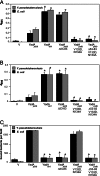Identification of a domain in Yersinia virulence factor YadA that is crucial for extracellular matrix-specific cell adhesion and uptake
- PMID: 16488979
- PMCID: PMC1413876
- DOI: 10.1073/pnas.0507749103
Identification of a domain in Yersinia virulence factor YadA that is crucial for extracellular matrix-specific cell adhesion and uptake
Abstract
For many pathogens, cell adhesion factors are critical virulence determinants. Enteropathogenic Yersinia species express the afimbrial adhesin YadA, the prototype of a class of homotrimeric outer membrane adhesins, which mediates adherence to host cells by binding to extracellular matrix components. In this study, we demonstrate that different pathogenic functions are attributable to highly homologous YadA proteins. YadA of Yersinia pseudotuberculosis (YadA(pstb)) and Yersinia enterocolitica (YadA(ent)) exhibit fundamental differences in their specificity of extracellular matrix substrate binding, they cause dissimilar bacterial aggregation behaviors, and YadA(pstb), but not YadA(ent), promotes efficient uptake into human cells. Evidence is presented here that a unique N-terminal amino acid sequence of YadA(pstb), which is absent in YadA(ent), acts as an "uptake domain" by mediating tight binding to fibronectin bound on alpha(5)beta(1) integrin receptors, which are crucial for initiating the entry process. Deleting this motif in YadA(pstb) generated all features of the YadA(ent) protein, i.e., the molecule lost its adhesiveness to fibronectin and its invasiveness, but gained adhesion potential to collagen and laminin. Loss of the "uptake region" also attenuated host tissue colonization by Y. pseudotuberculosis during oral infections of mice, demonstrating that this motif plays a crucial role in defining pathogen-host cell interaction and pathogenesis. We conclude that even small variations in adhesion factors can provoke major differences in the virulence properties of related pathogens.
Conflict of interest statement
Conflict of interest statement: No conflicts declared.
Figures




Similar articles
-
YadA, the multifaceted Yersinia adhesin.Int J Med Microbiol. 2001 Aug;291(3):209-18. doi: 10.1078/1438-4221-00119. Int J Med Microbiol. 2001. PMID: 11554561 Review.
-
Yersinia adhesin A (YadA)--beauty & beast.Int J Med Microbiol. 2015 Feb;305(2):252-8. doi: 10.1016/j.ijmm.2014.12.008. Epub 2014 Dec 24. Int J Med Microbiol. 2015. PMID: 25604505 Review.
-
Contribution of trimeric autotransporter C-terminal domains of oligomeric coiled-coil adhesin (Oca) family members YadA, UspA1, EibA, and Hia to translocation of the YadA passenger domain and virulence of Yersinia enterocolitica.J Bacteriol. 2008 Jul;190(14):5031-43. doi: 10.1128/JB.00161-08. Epub 2008 May 16. J Bacteriol. 2008. PMID: 18487327 Free PMC article.
-
Trimer stability of YadA is critical for virulence of Yersinia enterocolitica.Infect Immun. 2010 Jun;78(6):2677-90. doi: 10.1128/IAI.01350-09. Epub 2010 Mar 22. Infect Immun. 2010. PMID: 20308293 Free PMC article.
-
Distinct mechanisms of integrin binding by Yersinia pseudotuberculosis adhesins determine the phagocytic response of host macrophages.Cell Microbiol. 2005 Oct;7(10):1474-89. doi: 10.1111/j.1462-5822.2005.00571.x. Cell Microbiol. 2005. PMID: 16153246
Cited by
-
Adhesins and host serum factors drive Yop translocation by yersinia into professional phagocytes during animal infection.PLoS Pathog. 2013;9(6):e1003415. doi: 10.1371/journal.ppat.1003415. Epub 2013 Jun 20. PLoS Pathog. 2013. PMID: 23818844 Free PMC article.
-
Regions important for the adhesin activity of Moraxella catarrhalis Hag.BMC Microbiol. 2007 Jul 3;7:65. doi: 10.1186/1471-2180-7-65. BMC Microbiol. 2007. PMID: 17608944 Free PMC article.
-
Microscale communication between bacterial pathogens and the host epithelium.Genes Immun. 2021 Oct;22(5-6):247-254. doi: 10.1038/s41435-021-00149-1. Epub 2021 Sep 29. Genes Immun. 2021. PMID: 34588625 Free PMC article. Review.
-
Trimeric autotransporter DsrA is a major mediator of fibrinogen binding in Haemophilus ducreyi.Infect Immun. 2013 Dec;81(12):4443-52. doi: 10.1128/IAI.00743-13. Epub 2013 Sep 16. Infect Immun. 2013. PMID: 24042118 Free PMC article.
-
Cell behavior of the highly sticky bacterium Acinetobacter sp. Tol 5 during adhesion in laminar flows.Sci Rep. 2018 May 29;8(1):8285. doi: 10.1038/s41598-018-26699-5. Sci Rep. 2018. PMID: 29844614 Free PMC article.
References
Publication types
MeSH terms
Substances
LinkOut - more resources
Full Text Sources
Research Materials
Miscellaneous

